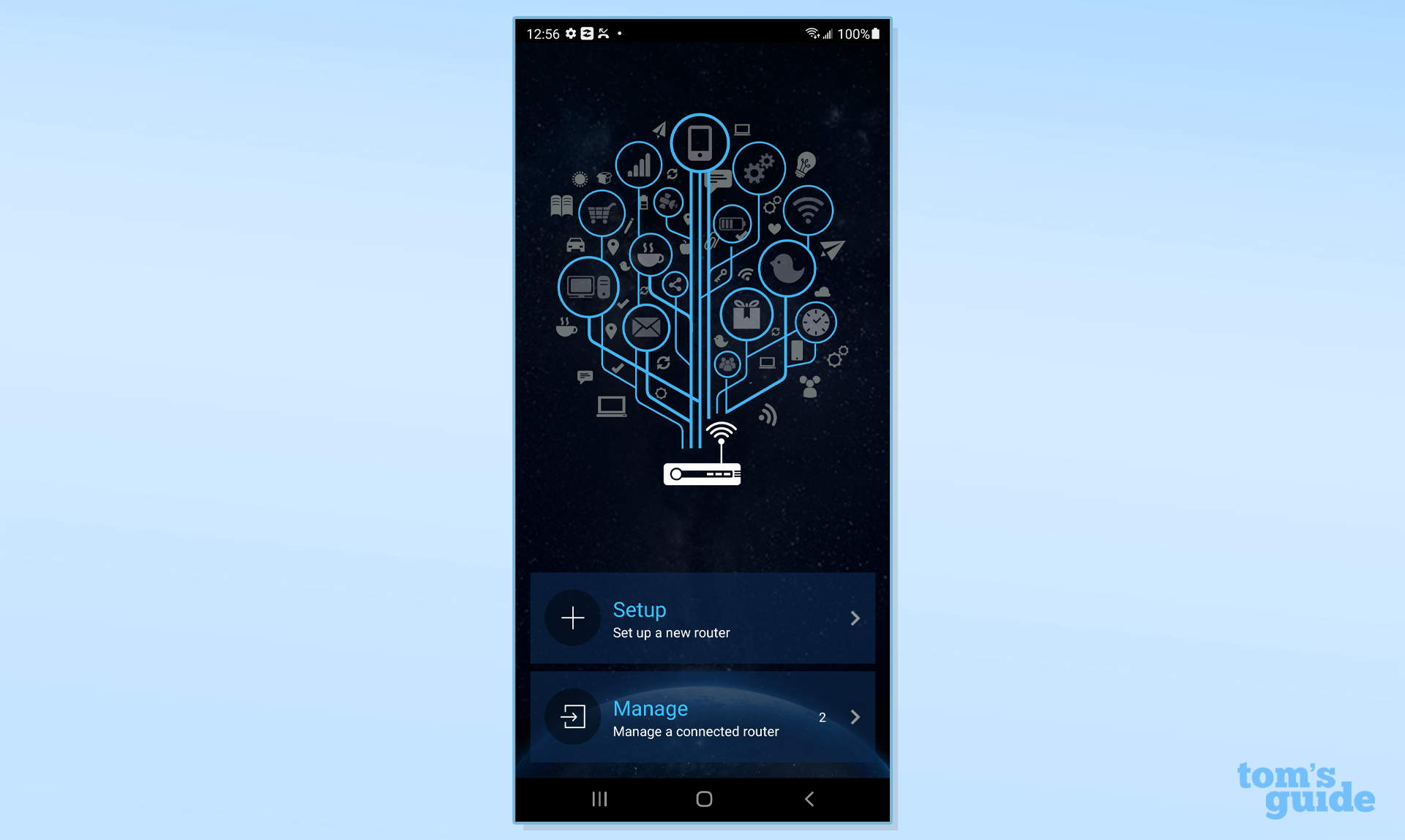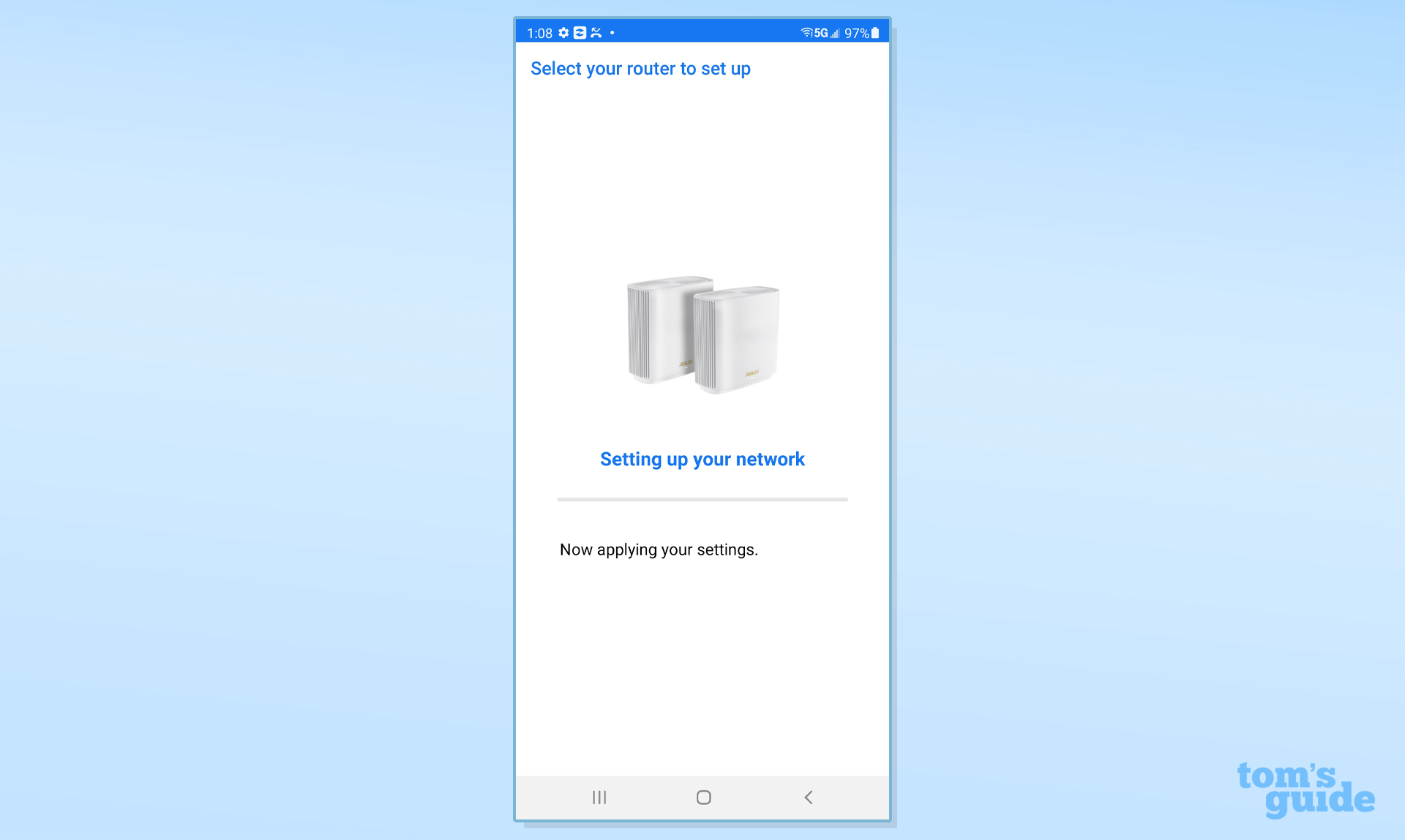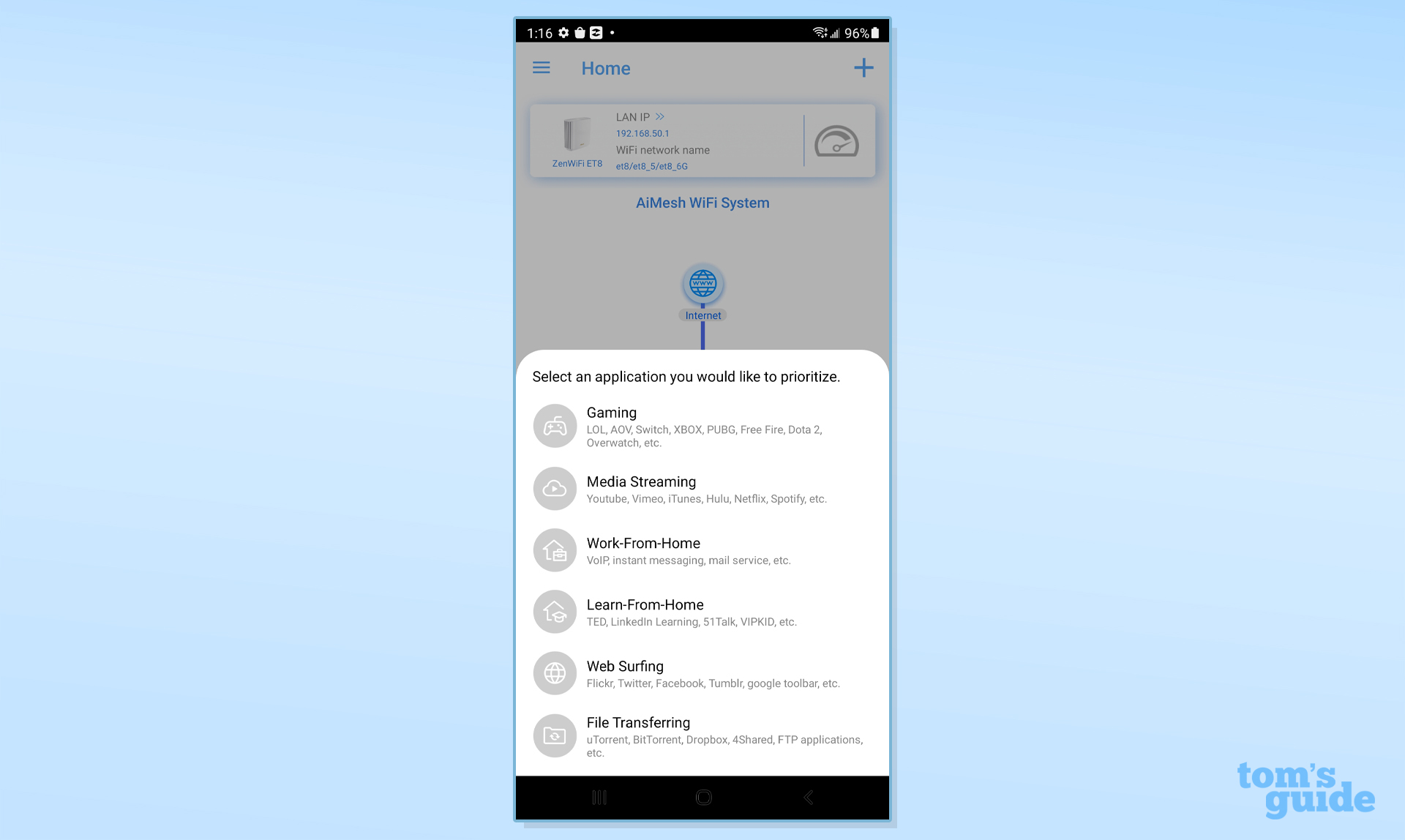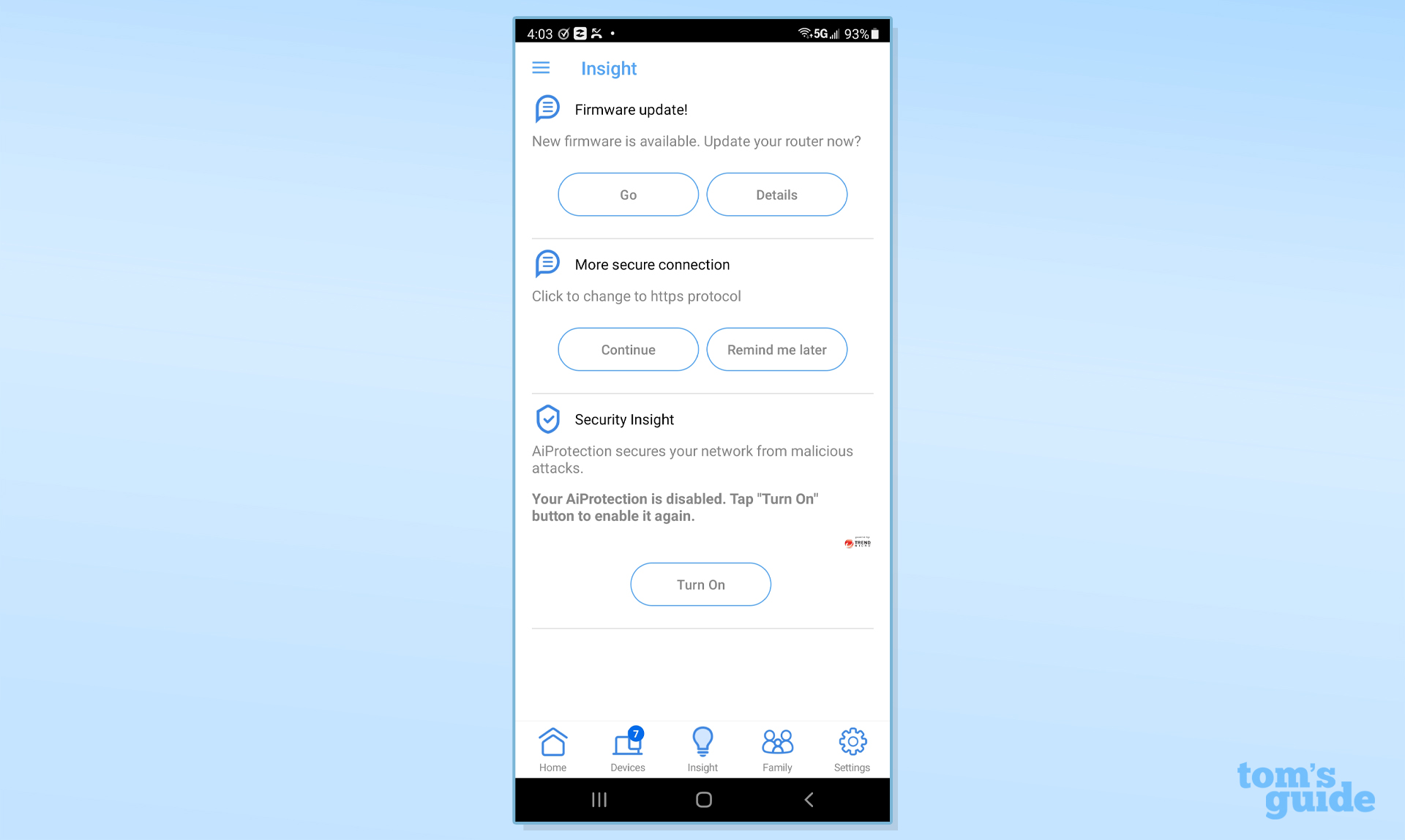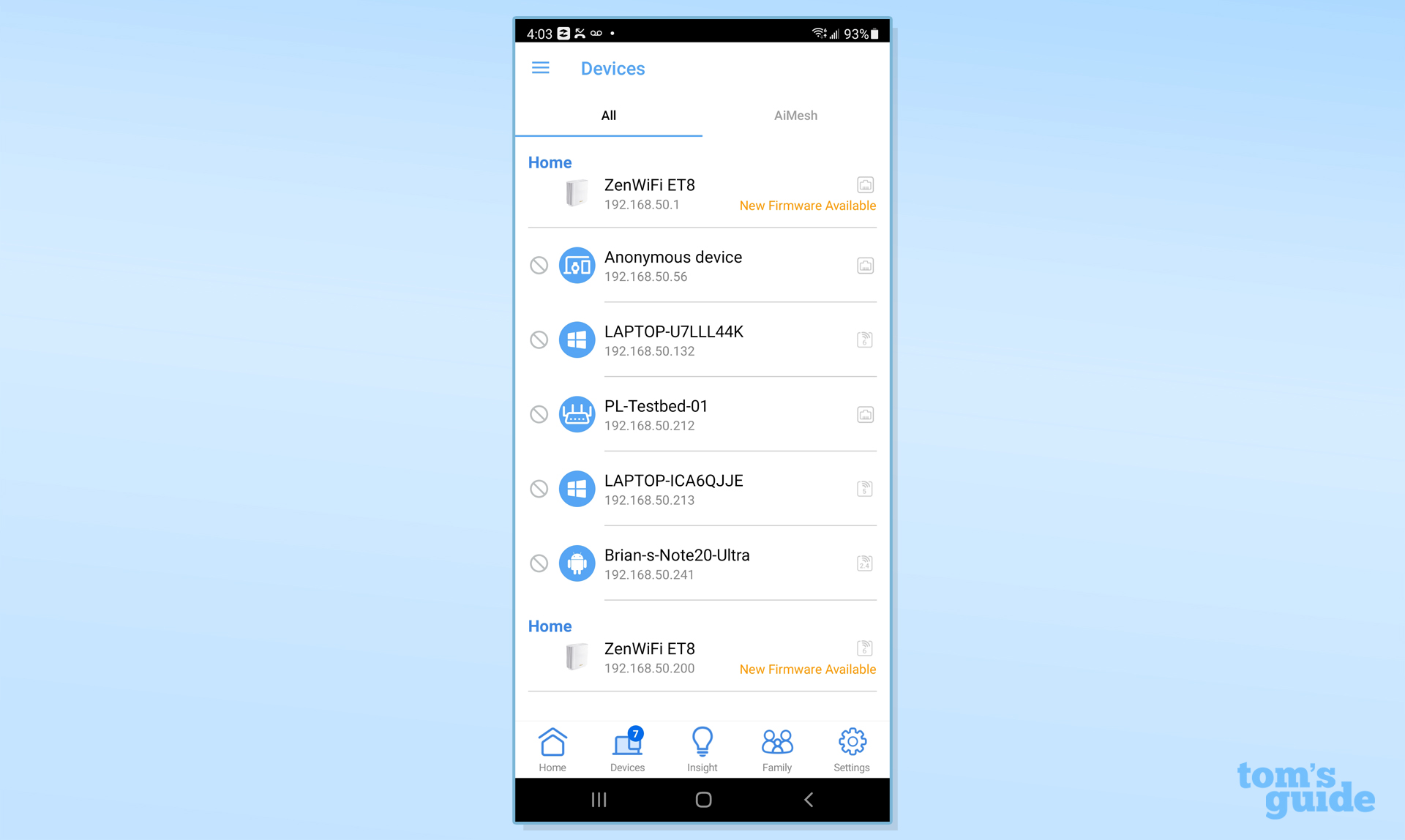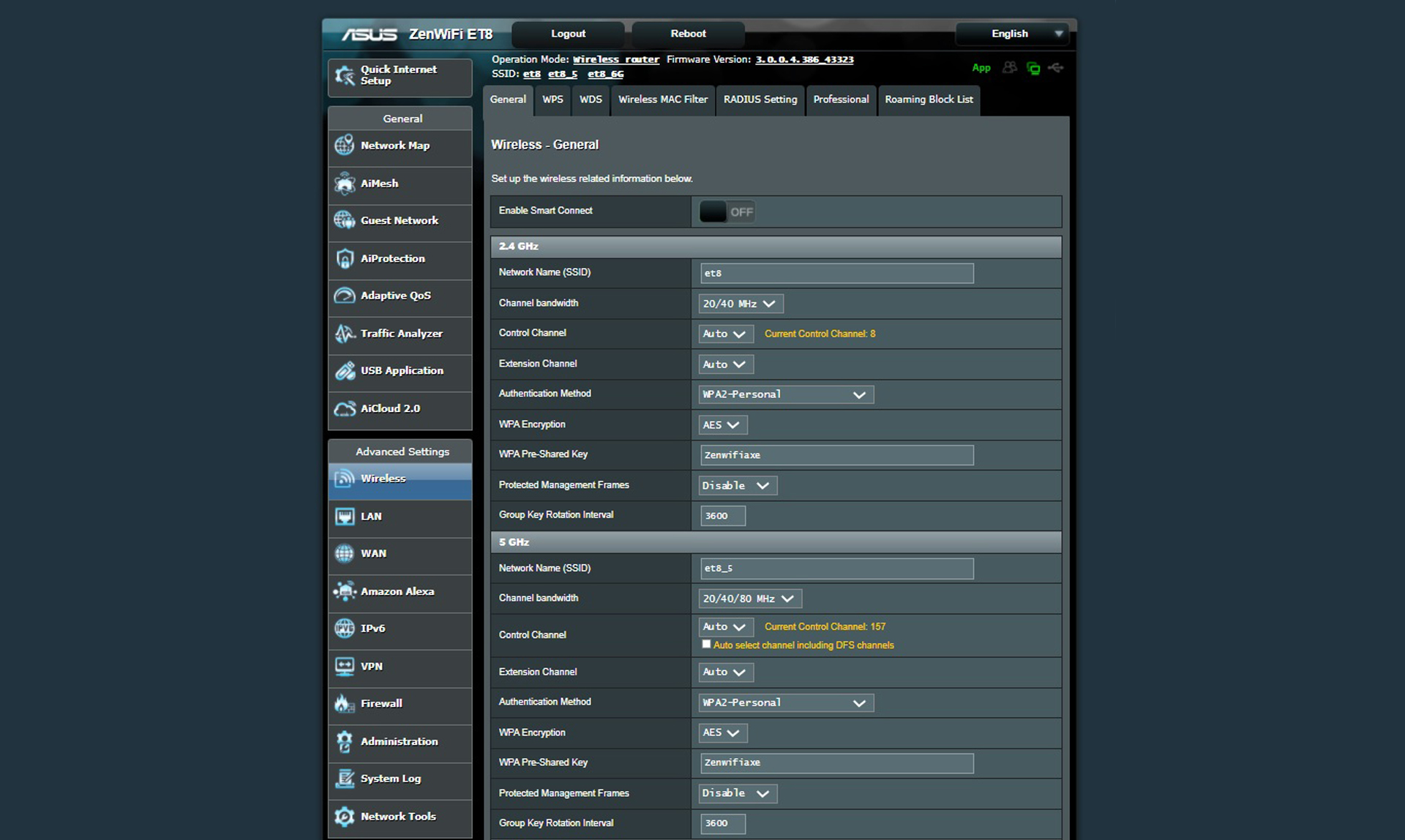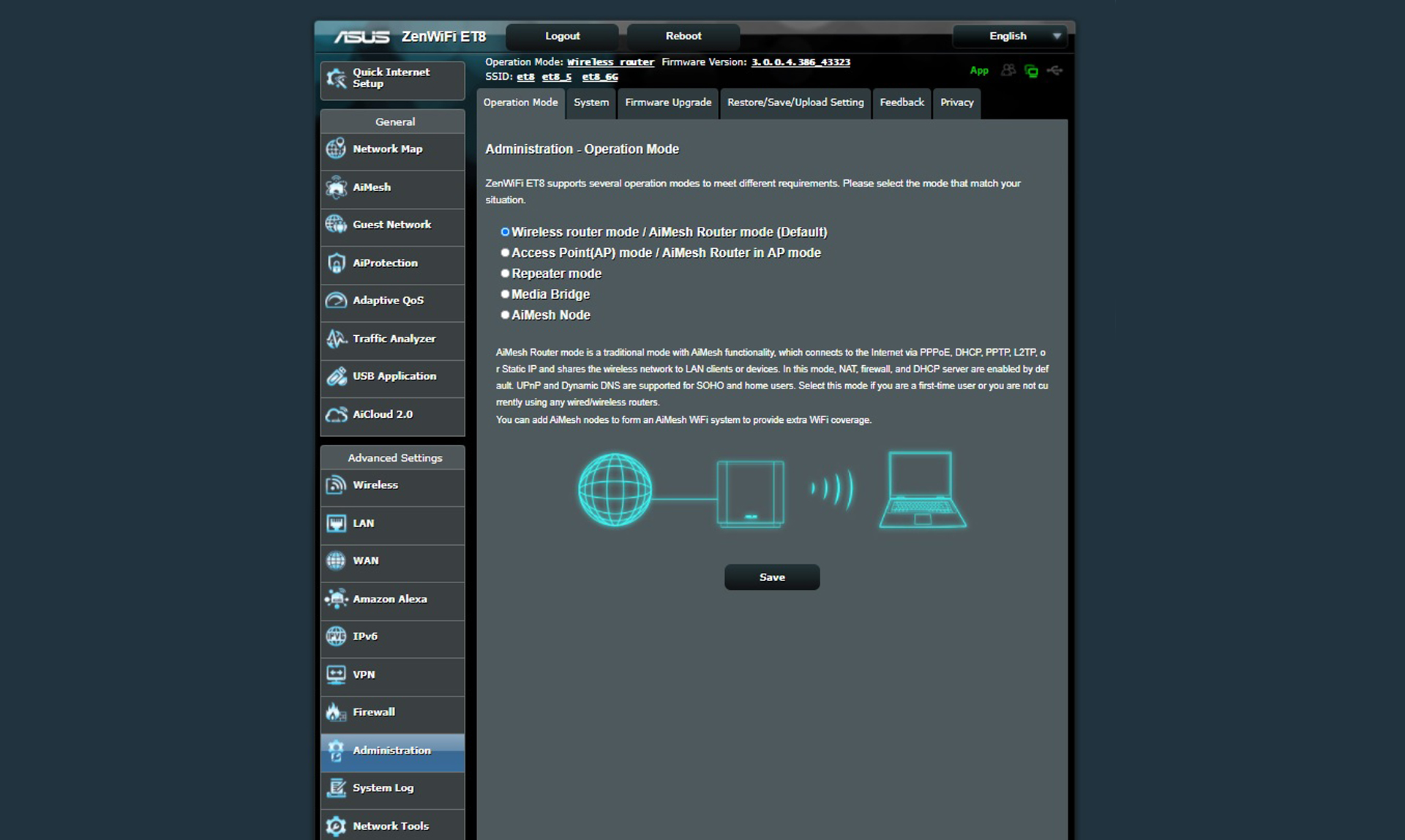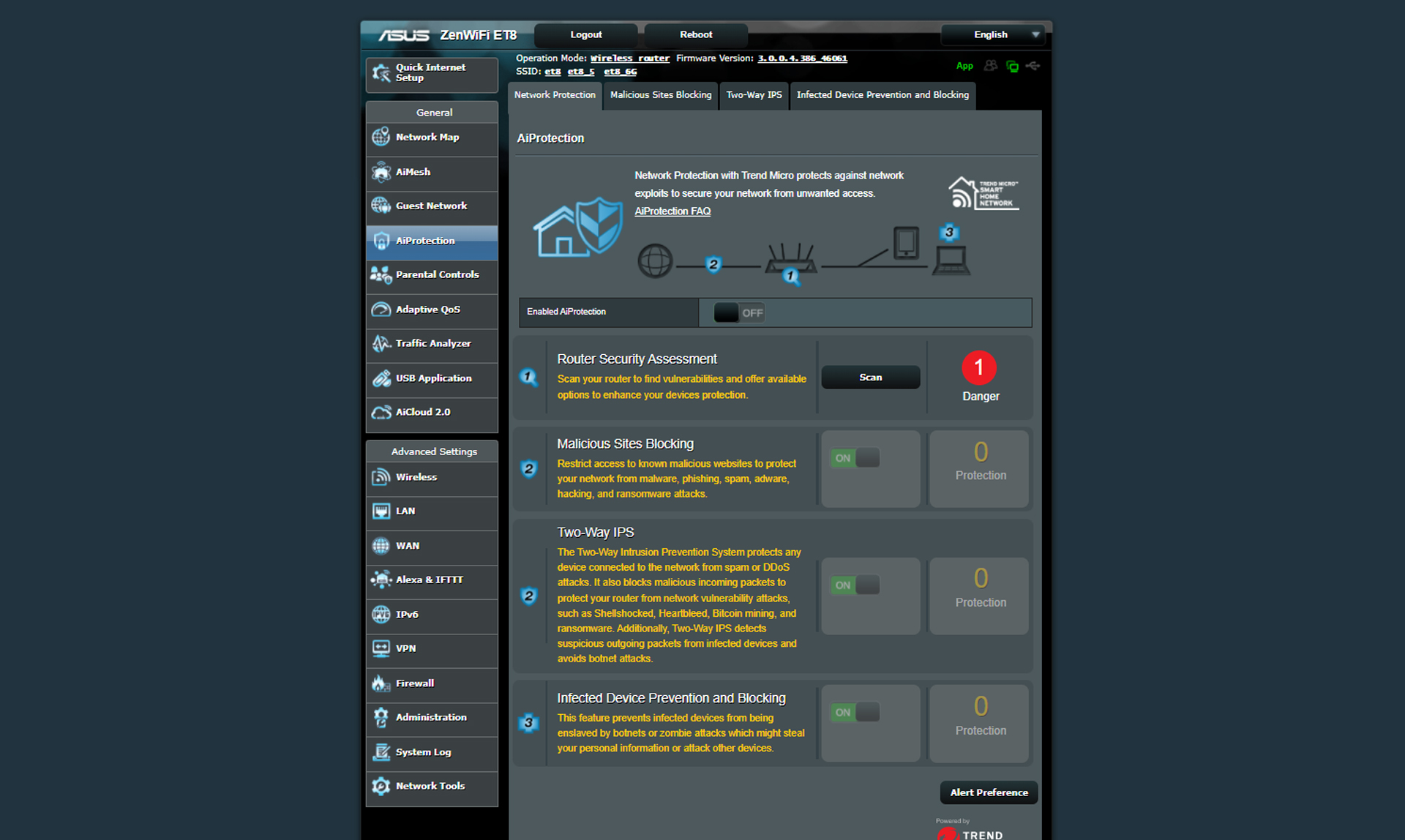Tom's Guide Verdict
The Asus ZenWiFi ET8 mesh kit takes the lead with its ability to move more data and stay online at greater distances than the competition while protecting with built-in security software.
Pros
- +
Excellent overall performance
- +
Great range
- +
Includes AI Protection security software
- +
Inexpensive
- +
Two-year warranty
Cons
- -
Three downstream LAN ports
- -
Can’t buy single ET8 units
Why you can trust Tom's Guide
Wi-Fi specification: AXE6600 (802.11ax, 6.6 Gbps throughput)
Number of antennas/removable: 6/No
Router ports: 1 WAN/3 LAN
Satellite ports: 3 LAN, can be used to connect satellite to router with cabling
Processor/memory/storage: Quad-core 1.5GHz/512MB/256MB
Wi-Fi chip: Broadcom BCM6755
Peak 802.11ax performance: 1.232 Gbps (at 15 feet)
Maximum range: 100 feet
Size: 6.4 x 6.3 x 2.9 inches
Estimated annual electricity cost: $18.60 (for router and satellite)
With the ability to deliver more data farther than other mesh networks, the Asus ZenWiFi ET8 is now the best in the growing Wi-Fi 6E class. The tri-band mesh kit comes with two units that reserve the 6GHz band for communications between the router and satellites, freeing an enormous amount of bandwidth for everything else. Its router and satellite will be more than enough for most homes, but right now you can’t buy single ET8 units.
In addition to the ability to customize network settings, the ET8 uses Asus’ AIProtection technology to block potential online hazards. The best part: unlike Netgear’s similar Armor software, AIProtection doesn’t need to be installed, is simpler to use and free.
While it does many things exceptionally well, the ET8 falls short in one area: The devices have only three downstream networking ports. If you have a complicated network, you might need a networking switch to make sure everything gets online. At $530 for two devices, the ET8 is priced significantly lower than the competition, making it close to our ideal mesh networking kit: inexpensive, fast and far reaching. Our Asus ZenWiFi ET8 review will help you decide if it's one of the best mesh routers and worth the upgrade.
Asus ZenWiFi ET8 review: Pricing and availability
Asus offers a more economical approach to Wi-Fi 6e mesh networking. The two-pack costs $530, putting it within reach for those who think the Orbi RBKE963 ($1,500) and Linksys Atlas Max 6E ($1,000) are too expensive. Asus plans to also sell single ET8 units later this year. The devices use transmissions in the 2.4 and 5 GHz Wi-Fi bands, and reserve 6GHz transmissions to connect the satellite to the router. According to Asus, the pair should be good for a 5,500 square foot home, while a single ET8 covers 2,750 square feet.
Asus ZenWiFi ET8 review: Design
Similar to Asus’s ZenWiFi XT8, the demure white ET8 units have heavily rounded walls and side cooling vents but lack chrome accent trim. The units are identical and are configured as a router or satellite during setup.
They each occupy 6.6 x 6.3 x 2.9 inches – one-half the size of Orbi RBKE963 units. Easy to hide on a bookshelf, desk or kitchen counter, the ET8 is the rare Wi-Fi router that actually looks good and should blend into the background. Unlike Netgear, Asus doesn’t sell its own wall brackets for the ET8, although there are several available online for about $15 each.
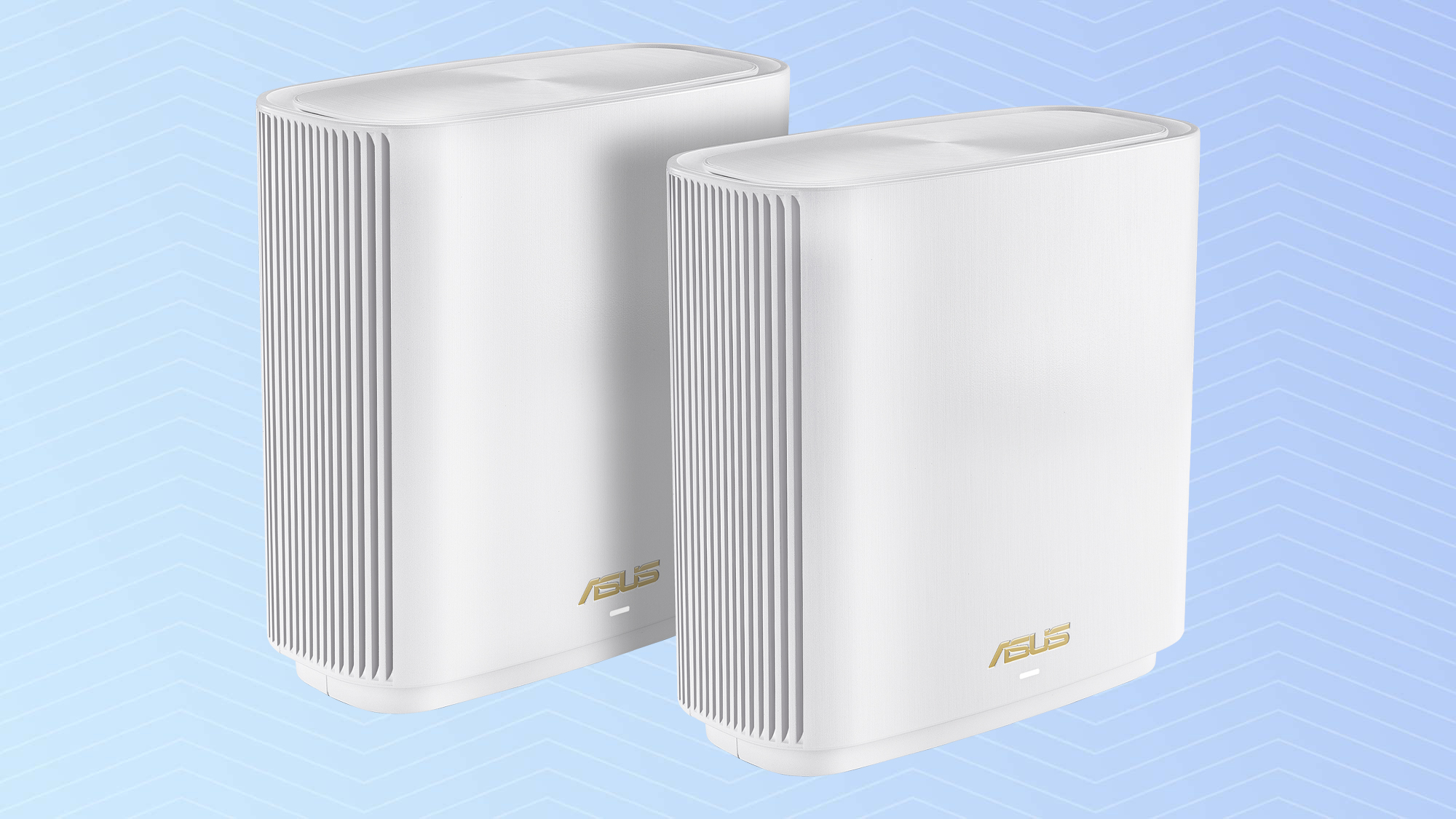
Forget about blinking LEDs, the ET8 has a single small LED bar that glows white when it’s online and working. If it’s yellow, the satellite is too far away and red means something more serious is afoot.
Get instant access to breaking news, the hottest reviews, great deals and helpful tips.
Each ET8 unit has a Broadcom BCM6755 Wi-Fi chip to move data back and forth. In addition to a 1.5GHz quad-core processor, the devices have 512MB of RAM and 256MB of flash storage space for firmware and settings. They each have six amplified antennas.
Once it’s set up, the ET8 router creates networks that use the 2.4, 5 and 6GHz Wi-Fi bands. It uses the 6GHz band to send data from its satellites to the router, although it can also use the 5GHz band.
Forget about blinking LEDs, the ET8 has a single small LED bar that glows white when it’s online and working. If it’s yellow, the satellite is too far away and red means something more serious is afoot.
Based on the 802.11ax spec, the ET8’s AIMesh system makes it one of the most up to date mesh kits around. It can set up 8 independent data streams that use beamforming to match the receiving device. Its use of MU-MIMO technology allows the router to service a large number of devices and as many as eight wide 160MHz data channels can be set up.
In addition to moving 574 Mbps over its 2.4GHz band, the ET8 can deliver up to 1.201 Gbps over the 5GHz band and as much as 4.804 Gbps over the 6GHz band. It adds up to an AXE6600 rating.
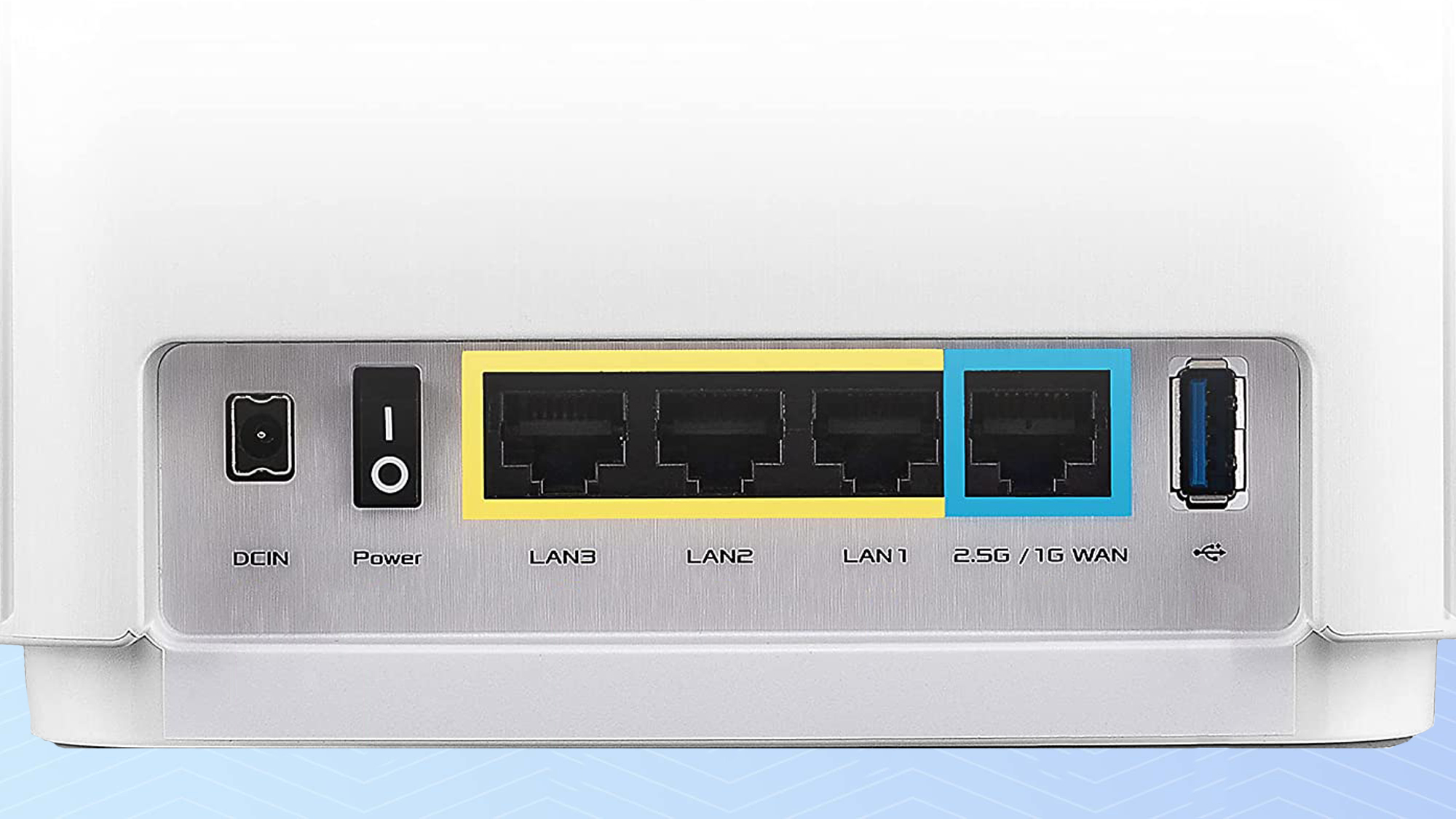
Along the device’s back are a power switch and WAN input that can work with 2.5 Gbps inputs. However, it shortchanges on gigabit per second downstream LAN ports with only three. Each device has a USB port for connecting a storage device as well as a reset button underneath.
Asus ZenWiFi ET8 review: Performance
When it came to filling my 100-year old 3,500 square foot home with data, the Asus ZenWiFi ET8 is a winner. Using Ixia's IxChariot networking benchmark to simulate 10 data-hungry users and a Samsung Galaxy Book Pro to measure performance, the ET8 pushed the Orbi RBKE963 aside and is the fastest mesh networking kit available.
With the test system set up 15 feet (about 4.5 meters) from the host router and no connected satellites, the network was able to send 1.232 Gbps of data. This just edges out the Linksys Atlas Max 6E’s 1.189 Gbps throughput and is 18 percent faster than the 1.009 Gbps that the Orbi RBRE960 router (from the RBKE963 kit) was capable of. It blew away Wi-Fi 6 mesh networks, like the Orbi RBK852 (at 883.6 Mbps), Arris Surfboard Max Pro (820.3 Mbps) and the TP-Link Deco X20 (622.1 Mbps).
The ZenWiFi ET8 nudges closer to our all-out speed king, the Netgear Nighthawk RAXE500 gaming router. On the downside, its throughput remains roughly half that of the high-performance router’s 2.396 Gbps at the same distance.
As I moved the test system away from the router, the 6GHz band lost contact and the throughput fell off quickly. At 50-feet (roughly 15 meters), the ET8 moved 287.7 Mbps, second best compared to the Atlas Max 6E’s 382.2 Mbps. However, it delivered one-third more throughput than the Orbi RBRE960 router’s 190.5 Mbps.
With 75-feet (about 23 meters) between the ET8 router and the test system, the network performed surprisingly well, doling out 151.8 Mbps. This compares well to the Orbi RBRE960’s 93.4 Mbps and is three-times the output of the Atlas Max 6E.
At 90-feet (27 meters), the ET8 moved 13.8 Mbps of data, plenty for watching videos but less than the Orbi RBRE960 router’s 39.9 Mbps; the Atlas Max 6E trailed with 6.7 Mbps of throughput. The ET8 has a 100-foot (roughly 30.5 meter) range, beating the RBRE960 (90-feet) and Atlas Max 6E (95-foot).
Its ability to send a strong signal across 25 feet (about 8 meters) and through a wall with 531.1 Mbps available, put the ET8 on a par with the Orbi RBRE960’s 547.9 Mbps. The speed champ here remains the Orbi RBK852 which can deliver 782.9 Mbps under the same circumstances.
I set the ET8’s satellite upstairs from the host router and the test system 40-feet (roughly 12 meters) down a hallway. The system was able to grab 434.0 Mbps of data. That’s more than four-times the 102.7 Mbps that the Atlas Max 6E and twice the Orbi RBKE963’s 163.4 Mbps throughput.
Overall, the ET8 two part kit filled my home with data but because it had only a router and satellite, there were slow spots. Adding a second satellite would have done the trick.
The ET8 was able to move more than enough data to pass my informal network saturation test. As I listened to the BBC World Service newsfeed on my iPad Pro, I viewed 4K video on a ThinkPad T470 while an HP Dragonfly laptop played HD videos. This all happened as a MacBook Air was moving data onto and off a networked RAID storage array. During testing, the audio and video streams came through without any skips or dropouts.
In spite of its high performance, the ET8 is a miser when it comes to power use with the router and satellite consuming 8.6- and 6.6-watts, respectively. That adds up to an annual estimate for electricity bills of $18.60, a fraction of the cost of the Orbi RBKE963 ($64/year) or Atlas Max 6E ($53/year), although both have two satellites.
Asus ZenWiFi ET8 review: Setup
Getting started with the Asus ZenWiFi ET8 is different from most other mesh kits. Instead of setting up the router and then adding satellites, the ZenWiFi ET8 gets going with the two parts next to each other. This simplifies the startup procedure and lets you move the satellite anywhere you want afterward.
With the two devices plugged in, I connected the one I wanted to be the router to my cable modem. Next, I opened the Asus Router app and verified that my phone’s Bluetooth was turned on. Once the devices started up, I connected my phone to the router’s LAN (“Asus_00”).
From the app, I picked Setup a new router and after that, I selected the ZenWiFi family of mesh products.
Then I used my phone’s camera to shoot the QR code under the router and the app connected to it
From here, I typed in names and passwords for the 2.4-, 5- and 6GHz bands. After creating an account with Asus, the app set up the networks and applied my settings. Everything worked on the first try.
The sequence ended with me moving the satellite upstairs and agreeing to the license terms. All told, it took six minutes.
Asus ZenWiFi ET8 review: Configuration
The Asus ZenWiFi ET8 can be configured with the app or with a browser. The former is quick, easy and visually oriented while the latter offers more options. The app’s main screen shows a schematic map of the network with the Internet on top and the ET8 router and satellite below.
Up top is the IP address as well as the network name. There’s a link to the right for checking the network’s speed.
There are six different optimization profiles that provide prioritization to anything from gaming and media streaming to work from home and file transfers. These choices present a good assortment of activities for getting the data to the right place.
Along the bottom, you can see which devices are online and set up parental controls. My favorite is the Insight section that suggests things that can make the router run better, like updating the firmware and using AIProtection.
The Settings link opens diagnostics as well as USB storage and Wi-Fi details. The stand out feature is the Traffic Statistics window that shows the flow across the three Wi-Fi bands.
By contrast, using a connected browser yields an amazing amount of information about the router, including a network map of connected clients. There’re links for USB storage, details of the three networks and what firmware version is in place.
The left side of the page has choices that range from setting up a guest network to the traffic analyzer (to see which bands are most used) to its Quality of Service (QoS) features. While the Wireless section lets you adjust the channel width and authentication method, it lacks things like customizing the CTS/RTS threshold or changing the preamble to long or short, which the Orbi RBKE963 can do.
The well hidden Administration area let me choose the Operation Mode to run the device in a mesh network, as an access point, media bridge or a repeater. It lacks the Orbi RBKE963’s ability to push smart home devices to the 2.4 or 5GHz bands.
Each ET8 unit includes Asus’s AIProtection to block dangerous programs from getting onto your network. Using software from Trend Micro, AIProtection lets you scan for problems and provides a security assessment. It doesn’t include the Bitdefender client software that comes with Netgear’s Armor ($99 a year), but with Asus, there’s no setup and you don’t have to pay.
The two-year warranty falls short of the three years that Linskys covers the Atlas Max 6E for. Both include lifetime technical support, which blows away the Netgear policy of one-year warranty and 90-days of support.
In addition to new firmware and manuals, the Asus website has a slew of FAQs. The company also offers 24/7 personal support via phone or email.
Asus ZenWiFi ET8 review: Verdict
In the fast moving world of Wi-Fi 6E, the Asus ZenWiFi ET8 is now the top dog to beat. It left Linksys’s Atlas Max 6E and Netgear’s Orbi RBKE963 in the dust in terms of throughput, range and at $550 for two devices – it’s the value king. With a reasonable choice of customization options, the network can be optimized to your heart’s content. Add in the included AIProtection security software and you have a mesh network that is not only fast and safe but inexpensive as well.
Brian Nadel is a freelance writer and editor who specializes in technology reporting and reviewing. He works out of the suburban New York City area and has covered topics from nuclear power plants and Wi-Fi routers to cars and tablets. The former editor-in-chief of Mobile Computing and Communications, Nadel is the recipient of the TransPacific Writing Award.


